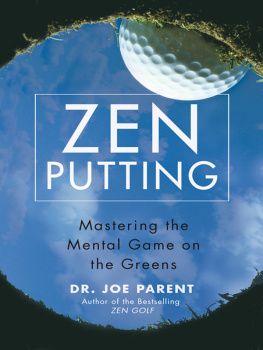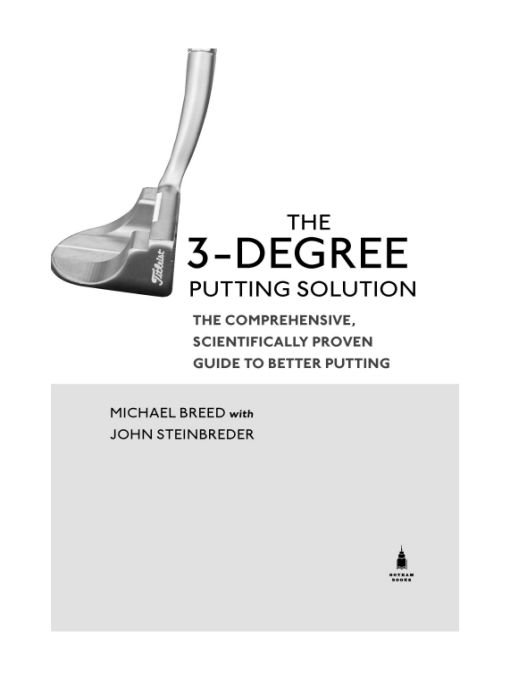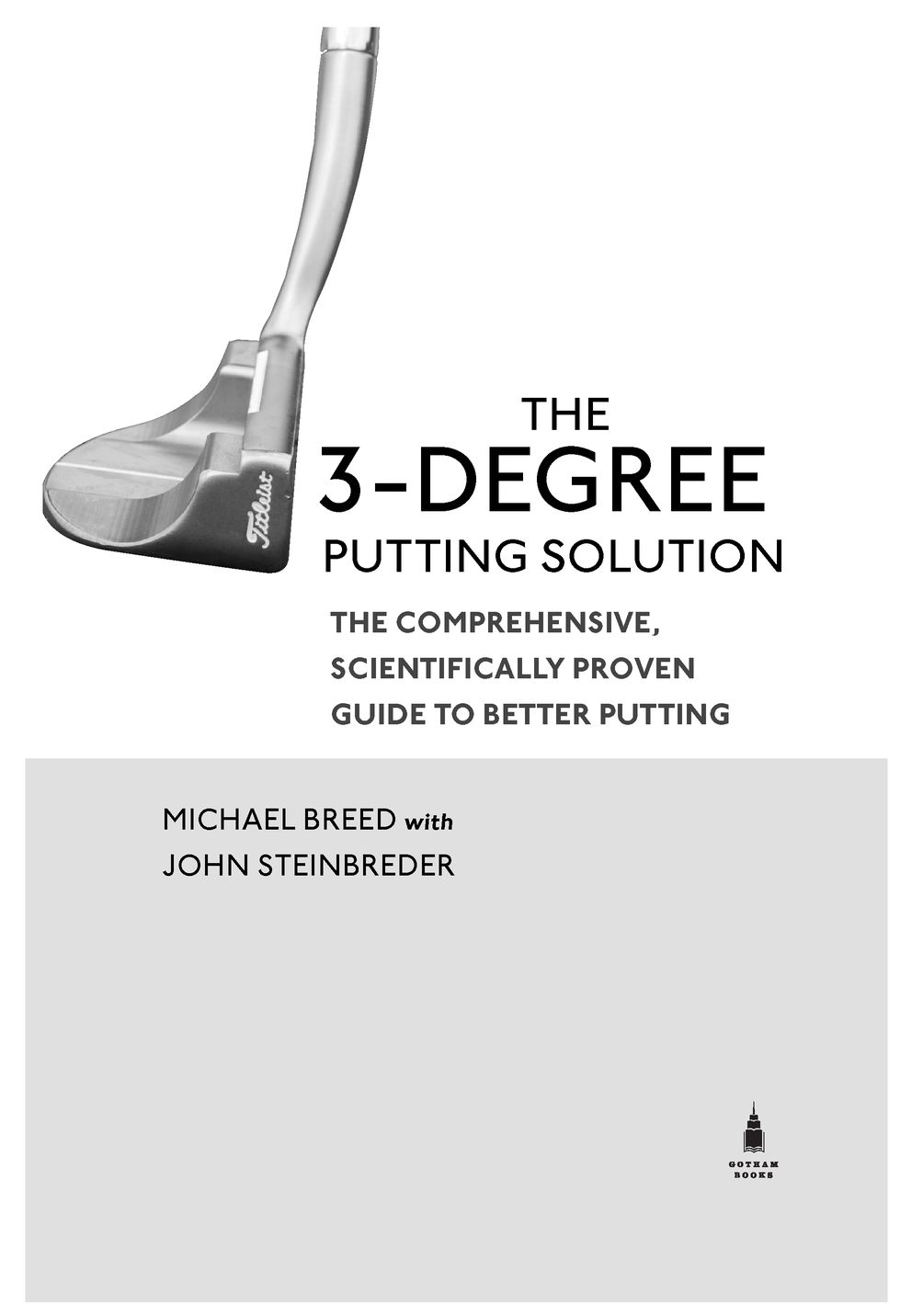Table of Contents
To my wife, Kerri. Your love, trust, honesty, humor, patience, support, beauty, intelligence, and character are more than I dreamed possible. You are the blessing of my life. The wait was so worth it. I love you.
INTRODUCTION
What I Found in the Morning Dew
THE IDEA FIRST CAME TO ME NEARLY THIRTY YEARS AGO, WHEN I was practicing early one morning before a round of golf with my father. I was putting golf balls across a dew-covered green and could clearly see the line of each Titleist as it cut through the thin film of water covering the closely cropped grass. The ball always jumped into the air immediately after impact with my putter face, landing on the ground a few inches from where it had been resting and leaving a mark in the dew. It bounced a few times, and only then did it actually start rolling.
I was curious about that, as I had never understood why a ball hopped off a putterface. I figured it might have been because most off-the-rack putters, including the one I was using at the time, had a couple of degrees of loft built into them, and that loft forced the ball into the air. Then I thought I might be doing something wrong when I stroked the ball. So I started toying with shaft positions to see what sorts of changes I could make to the way the ball reacted when I hit it.
Thats how I usually am when I practice. Im curious. I like to tinker. I notice things like the sound a ball makes when it comes off the clubface and the shape of a divot after a shot. Im always interested in ways I can improve my game and help those around me, too. I love figuring things out.
Fiddling with my putter that day, I quickly realized that by leaning the shaft forward, I was able to transform the loft from positive to negative. In the process, I all but eliminated that jump in the ball, and it began to roll more consistently to the cup with topspinand not check up with backspin the way it did when it landed after that initial hop. The ball didnt slow down so quickly, or die so suddenly to the short side of the cup, and I found myself stroking each putt with a pure roll.
My first reaction was: This is very cool! My second reaction was: I think Ive discovered something pretty significant.
Actually, rediscovered is a better word, because what I had stumbled upon was a truth that the great putters of yesteryear had known: A golfer creates forward rotation when he hits his putts with negative loft. The result of that forward rotation is consistent speed and ball direction, which allows players to be more effective putters. Thats what Billy Casper, Horton Smith, and Bobby Locke did as they putted their ways into the World Golf Hall of Fame. Its also the method Dave Stockton used to win two PGA Championships, and to earn the praise of his fellow pros as one of the best flatstick players (and teachers) of all time. In fact, Walter Travis, who won the U.S. Amateur in 1900 and the British Amateur four years later, had similar ideas. Travis was a superb short-game artist who famously gave Bobby Jones a lesson that the golfing great credited with making him a better putter. And the center-shafted, mallet-headed Schenectady putter Travis used to win so many of his championships remains one of the most famous clubs golf has ever known. He also published a much praised book in 1901, Practical Golf, espousing several theories on putting. Including this one: So it is with a straight-faced putter as against one a trifle lofted or laid back. The more it [a putter face] is laid back, the greater is the undercut or backward spin and the harder must the ball be struck.
The problem was, most modern golf instructors had long ago forgotten that truth about negative loft, and it had been years since anyone had actively promoted or taught the concept. Instead, they advocated positive loft, among other alternative putting theories.
As for me, I didnt even think about Casper and Locke or Stockton and Smith that day on the practice green when I first moved my hands forward and leaned my puttershaft toward the cup to see if I could get the ball to jump a little lessand roll a little more. I was young. I had no idea the direction I would take in this great game of golf. I didnt know that I would become a well-respected teaching professional. I was simply trying to make sense of something I did not understand. And the more I worked with that approach, the more I saw the benefits. It was hard to hold back a happy, satisfied grin.
Ben Hogan famously said he uncovered his secrets of the game in the dirt of the practice tee. I had found mine in the morning dew, although it would be more than twenty years before I could truly verify those discoveries.
To better understand how and why the golf ball reacted differently to negative loft, I thought of the behavior of a cue ball in pool. If a player wants to create backspin and cause the ball to stop suddenly, the contact point with the cue stick is the lower half of the ball, below the equator. If, however, he wants to create forward rotation so the ball rolls directly to the hole, the contact point must be the upper half.
The only way to reach a contact point on the lower half of a golf ball is with a putter that has positive lofti.e., one in which the clubface slants slightly back from the bottom to the top, the same way the face of a driver or 5-iron does, only much less so. The greater the loft, the lower the impact point. To create forward rotation, and hit the golf ball above the equator, a player needs to have his putter in a forward position when he makes contact. He has to create that negative loft, in which the upper part of the putter hits the upper part of the ball and creates a higher impact point.
On that morning when I first noticed the way in which the golf ball rolled, I was in college, playing competitively for the golf team at Randolph-Macon College, a small, Division III school in Ashland, Virginia. I thought seriously about playing for a living after I graduated from there in 1985 with a degree in psychology. I entered some mini-tour events in Florida and New England, but it didnt take long to realize that while I was a good player, I was not PGA Tour caliber. So I began to teach, first as an assistant pro at the Dorset Field Club in Dorset, Vermont, and then at the Birchwood Golf Club in Westport, Connecticut. And it was at those jobs that I started to think long and hard about the putting strokeand started to formulate the theories that Im advancing in this book.
My interest in putting actually started when I looked at my own game when I was competing and thought about the ways I could get better. Better ballstriking was one, of course. And putting another. So I started keeping track of my puttswhich ones I made, which ones I missed, and why. Then my research moved into my work as an instructor, where I saw the different ways my students struggled with their putting and what tweaks and fixes helped improve their performances. And it wasnt long before I expanded my studies beyond the practice green and started examining the techniques of the games best putters in books, magazines, and on video. Thats when I found that so many of them had created negative loft, either by leaning their clubshaft forward slightly (which is what the great Mickey Wright did), or by hooding the face (which was Horton Smiths style). Thats when I knew I was onto something.
However, I also knew I had much more work to do in order to counter the new conventional wisdom. This was the late 1980s, when a technology revolution was shaking up golf and the greatest equipment advances in the history of the game were coming onstream. Many equipment makers were using high-speed cameras to study the putting stroke and how golf balls reacted when they were struck. One of the pivotal insights from that time was the observation that the weight of a golf ball sitting motionless on a green created a slight depression in the turf. The ball, they pointed out, was nestled in an almost imperceptible cup. As a result, manufacturers and designers decided that putters needed to have a loft of about 3 or 4 degrees so that golfers could lift or pop their golf ball out of this depression and send it toward the hole. Golf instructors soon began buying into that argument, and as a result, they began seeing positive loft as the solution to a newly discovered problem.










